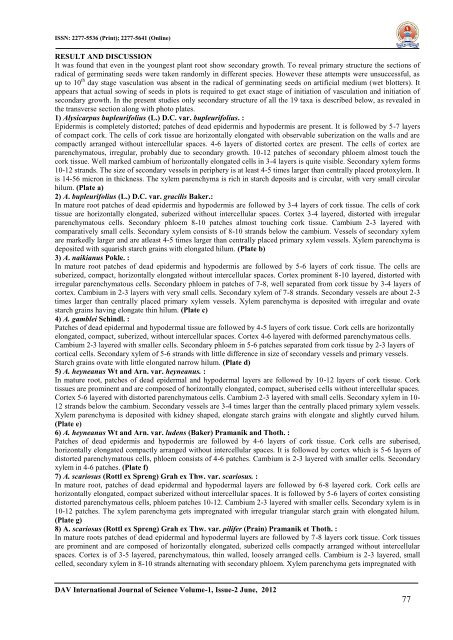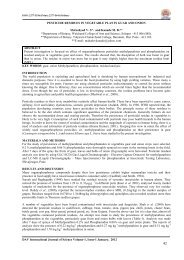STUDY OF ROOT ANATOMY IN THE GENUS ... - davjournal.org
STUDY OF ROOT ANATOMY IN THE GENUS ... - davjournal.org
STUDY OF ROOT ANATOMY IN THE GENUS ... - davjournal.org
You also want an ePaper? Increase the reach of your titles
YUMPU automatically turns print PDFs into web optimized ePapers that Google loves.
ISSN: 2277-5536 (Print); 2277-5641 (Online)RESULT AND DISCUSSIONIt was found that even in the youngest plant root show secondary growth. To reveal primary structure the sections ofradical of germinating seeds were taken randomly in different species. However these attempts were unsuccessful, asup to 10 th day stage vasculation was absent in the radical of germinating seeds on artificial medium (wet blotters). Itappears that actual sowing of seeds in plots is required to get exact stage of initiation of vasculation and initiation ofsecondary growth. In the present studies only secondary structure of all the 19 taxa is described below, as revealed inthe transverse section along with photo plates.1) Alysicarpus bupleurifolius (L.) D.C. var. bupleurifolius. :Epidermis is completely distorted; patches of dead epidermis and hypodermis are present. It is followed by 5-7 layersof compact cork. The cells of cork tissue are horizontally elongated with observable suberization on the walls and arecompactly arranged without intercellular spaces. 4-6 layers of distorted cortex are present. The cells of cortex areparenchymatous, irregular, probably due to secondary growth. 10-12 patches of secondary phloem almost touch thecork tissue. Well marked cambium of horizontally elongated cells in 3-4 layers is quite visible. Secondary xylem forms10-12 strands. The size of secondary vessels in periphery is at least 4-5 times larger than centrally placed protoxylem. Itis 14-56 micron in thickness. The xylem parenchyma is rich in starch deposits and is circular, with very small circularhilum. (Plate a)2) A. bupleurifolius (L.) D.C. var. gracilis Baker.:In mature root patches of dead epidermis and hypodermis are followed by 3-4 layers of cork tissue. The cells of corktissue are horizontally elongated, suberized without intercellular spaces. Cortex 3-4 layered, distorted with irregularparenchymatous cells. Secondary phloem 8-10 patches almost touching cork tissue. Cambium 2-3 layered withcomparatively small cells. Secondary xylem consists of 8-10 strands below the cambium. Vessels of secondary xylemare markedly larger and are atleast 4-5 times larger than centrally placed primary xylem vessels. Xylem parenchyma isdeposited with squarish starch grains with elongated hilum. (Plate b)3) A. naikianus Pokle. :In mature root patches of dead epidermis and hypodermis are followed by 5-6 layers of cork tissue. The cells aresuberized, compact, horizontally elongated without intercellular spaces. Cortex prominent 8-10 layered, distorted withirregular parenchymatous cells. Secondary phloem in patches of 7-8, well separated from cork tissue by 3-4 layers ofcortex. Cambium in 2-3 layers with very small cells. Secondary xylem of 7-8 strands. Secondary vessels are about 2-3times larger than centrally placed primary xylem vessels. Xylem parenchyma is deposited with irregular and ovatestarch grains having elongate thin hilum. (Plate c)4) A. gamblei Schindl. :Patches of dead epidermal and hypodermal tissue are followed by 4-5 layers of cork tissue. Cork cells are horizontallyelongated, compact, suberized, without intercellular spaces. Cortex 4-6 layered with deformed parenchymatous cells.Cambium 2-3 layered with smaller cells. Secondary phloem in 5-6 patches separated from cork tissue by 2-3 layers ofcortical cells. Secondary xylem of 5-6 strands with little difference in size of secondary vessels and primary vessels.Starch grains ovate with little elongated narrow hilum. (Plate d)5) A. heyneanus Wt and Arn. var. heyneanus. :In mature root, patches of dead epidermal and hypodermal layers are followed by 10-12 layers of cork tissue. Corktissues are prominent and are composed of horizontally elongated, compact, suberised cells without intercellular spaces.Cortex 5-6 layered with distorted parenchymatous cells. Cambium 2-3 layered with small cells. Secondary xylem in 10-12 strands below the cambium. Secondary vessels are 3-4 times larger than the centrally placed primary xylem vessels.Xylem parenchyma is deposited with kidney shaped, elongate starch grains with elongate and slightly curved hilum.(Plate e)6) A. heyneanus Wt and Arn. var. ludens (Baker) Pramanik and Thoth. :Patches of dead epidermis and hypodermis are followed by 4-6 layers of cork tissue. Cork cells are suberised,horizontally elongated compactly arranged without intercellular spaces. It is followed by cortex which is 5-6 layers ofdistorted parenchymatous cells, phloem consists of 4-6 patches. Cambium is 2-3 layered with smaller cells. Secondaryxylem in 4-6 patches. (Plate f)7) A. scariosus (Rottl ex Spreng) Grah ex Thw. var. scariosus. :In mature root, patches of dead epidermal and hypodermal layers are followed by 6-8 layered cork. Cork cells arehorizontally elongated, compact suberized without intercellular spaces. It is followed by 5-6 layers of cortex consistingdistorted parenchymatous cells, phloem patches 10-12. Cambium 2-3 layered with smaller cells. Secondary xylem is in10-12 patches. The xylem parenchyma gets impregnated with irregular triangular starch grain with elongated hilum.(Plate g)8) A. scariosus (Rottl ex Spreng) Grah ex Thw. var. pilifer (Prain) Pramanik et Thoth. :In mature roots patches of dead epidermal and hypodermal layers are followed by 7-8 layers cork tissue. Cork tissuesare prominent and are composed of horizontally elongated, suberized cells compactly arranged without intercellularspaces. Cortex is of 3-5 layered, parenchymatous, thin walled, loosely arranged cells. Cambium is 2-3 layered, smallcelled, secondary xylem in 8-10 strands alternating with secondary phloem. Xylem parenchyma gets impregnated withDAV International Journal of Science Volume-1, Issue-2 June, 201277




